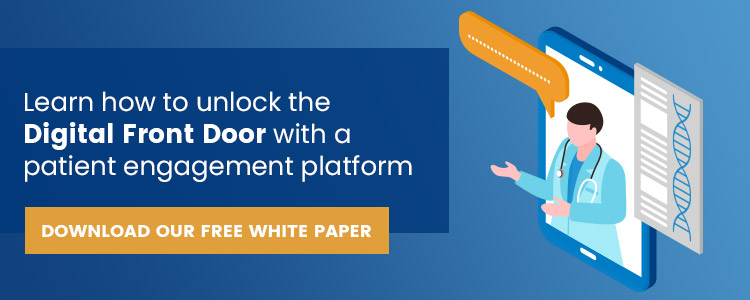5 Mandatory Features To Have Within An EHR Patient Portal For Any Healthcare Organization Targeting Growth
- Dr. Leo P. Langlois
- July 23, 2021

Healthcare leaders in the United States are rapidly embracing digitization to improve staff efficiency, augment patient care, and increase the overall bottom line of their practices.
However, even as the majority of care providers depict a willing eagerness when it comes to incorporating digital health solutions, the imbalance between the rate of patient utilization of some of the software and the clinical support they demand is huge.
This is especially true for EHR patient portals.
Despite becoming omnipresent in healthcare facilities across the nation, 62% of US hospitals[¹] report that their patient portals are used by less than one quarter of their patient base.
Addressing these utility challenges is critical to getting more patients involved in their health and making a seamless shift to a proactive, value-based care approach.
This can easily be done by employing a few essential features within the patient portals to derive more value from them and attract more patients to your practice. These features include:
1) An Interface that’s User Friendly
More often than not, an over-complicated user interface (UI) design happens to be one of the greatest setbacks that complicates things for the majority of patients.
For instance, even if a patient initially feels enthusiastic to use a self-service portal, their initial motivation can easily dissipate due to inefficiencies they encounter and result in frustration.
Bad experiences that patients encounter when using an EHR patient portal can be discouraging and negatively impact the engagement levels.
A well-formulated and carefully thought out UI framework needs to be a mandatory feature to consider when designing a patient portal. A skilled developer would work on creating a design that facilitates robust user experience and keeps patients engaged with your organization.
2) Robust Security Controls
Healthcare data is becoming a prime target for hackers worldwide with each passing day. Their theft techniques have rapidly advanced over time and they are continually innovating to gain access to this sensitive and valuable set of information.
As a result, the increased sharing of patient data has led to the demand for more secure patient portals, which can act as effective tools for safe exchange of data between patients and providers, enhanced communication, and better care management.
Some of the features you can employ within a patient portal for increased patient data security include:
- Encrypted Database Features,
- Providing Role-based Access Control,
- Extensive Password Protection,
- Multi-Factor Authentication (MFA),
- Audit Trails, and
- Compliance with HIPAA[²] (Health Insurance Portability and Accountability Act).
3) Streamlined Payments
One recent report published by TransUnion[³] goes on to state that close to 62% of patients say knowing the healthcare expenses they will have to bear before the treatment begins has a direct impact on the likelihood of them pursuing care. The report further states that 68% of customers fail to completely pay off the balances of their medical bills.
To settle these concerns, a number of patient-focused self-service solutions available in the market today embed a component within their platform that supports a comprehensive variety of payment options. This further provides patients with transparency and a range of choices when it comes to managing health finances.
Some of the features commonly being embedded within these platforms today include billing queries, e-payments, payment history and retrieval, insurance support, and more.
By including a patient bill pay portal, healthcare businesses can not only increase patient portal utilization and improve patient engagement, but also manage and monitor patient collections to boost recovery rates.
4) API Integration
EHR patient portals generally integrate with on-premise EHR systems. However, by choosing to extend to open API, data integration from IoT devices and other third-party digital solutions (e.g., sleep trackers, glucose monitors, step counters, etc.) is also made possible.
Open APIs have become a useful feature for any healthcare organization trying to grow its customer base with a patient portal.
Once patients integrate their portal profiles with medical devices that store all data on a dedicated cloud server[⁴], the health information they input on the platform is synced automatically. This also increases interoperability of important health data.
The real-time flow of information between different health systems and tracking devices has further helped healthcare providers to easily review patient vitals on a regular basis and make informed decisions about the treatment protocol to be followed.
5) Digital Forms
Online registration forms make the registration workflow seamless for both patients as well as their providers by offering a time-efficient, fast and hassle free way for care seekers to fill out their consents and details even before the appointment with the physician takes place.
Digital forms have proven effective in reducing patient wait time in medical facilities while providing a safe and secure means of healthcare data collection that remains end-to-end encrypted.
Healthcare providers also reap the benefits of this feature as it helps in mitigating the burden on the reception staff, streamlining the operational workflow, reducing the risk of clinical errors caused by erroneous data, and delivering a complete picture of a patient’s medical history.
All in all, in order to come up with a solution that’s high on usability and easy to understand, you need to rethink every aspect of the EHR patient portal and mold its usability to appeal to the requirements of your patient base.
Try keeping yourself updated on recent market trends, customer demands and what your industry counterparts are doing to attract patients. A comparative analysis of all these factors will give you an idea about what you should be looking for when getting a solution designed for your practice.
- Henry, J., Barker, W. and Kachay, L. (n.d.). Electronic Capabilities for Patient Engagement among U.S. Non-Federal Acute Care Hospitals: 2013-2017. [online] . Available at: https://www.healthit.gov/sites/default/files/page/2019-04/AHApatientengagement.pdf
- Kamani, D.V. (2020). A HIPAA Compliant Website’s 7 Important Considerations. [online] Available at: https://arkenea.com/blog/hipaa-compliant-website/
- News Reports about a Weakening Economy Impacting How Some Patients Seek Medical Treatment. (n.d.). News Reports about a Weakening Economy Impacting How Some Patients Seek Medical Treatment. [online] Available at: https://newsroom.transunion.com/news-reports-about-a-weakening-economy–impacting-how-some-patients-seek-medical-treatment/
- Atlantic.net. (2021). What Is the Difference Between a Dedicated Server and a Dedicated Cloud Host? [online] Available at: https://www.atlantic.net/dedicated-server-hosting/what-is-the-difference-between-a-dedicated-server-and-a-dedicated-cloud-host/
